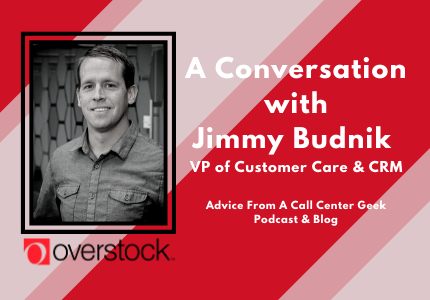A Conversation with the VP of Customer Care and CRM at Overstock.com- Jimmy Budnik

We have been pretty selective with the guests we interview for the Geek podcast & Blog. This guest next guest will be offering some great insights on customer experience and what new tools and strategies we can use in the future. We will also peer into some of the “behind the scenes” of what it is like to run a large retail/sales operation. With us today we have Jimmy Budnik, the VP of Customer Care and CRP at Overstock.com.
Tom: Please introduce yourself!
Jimmy: Hi! I’m Jimmy Budnik, the VP of customer Care and CRP at Overstock.com. I’m a bit of what I’ll call a “transplant call center geek”. I started off as an industrial engineer, so really in that kind of manufacturing/logistics world before coming to Overstock. And really early on I was asked to work on reverse Logistics and returns, and that was my first exposure to the customer care team at Overstock. I’ve been at Overstock just over 12 and a half years. I didn’t join the customer care team until three years ago. So over the first nine years, I really spread my experience between merchandising, marketing, some of the technology teams, really building a 360 view of what e-commerce retail looks like. Three years ago the senior vice president, who was both over the merchandizing team I was working on and customer care, tapped me on the shoulder and gave me this great opportunity to come over and join the team. I learned a lo from my directors who are tenured call center experts, but I was also able to teach a lot because of the experience I brought back from other departments within retail.
Tom: I think a lot of interesting things happen in retail around the holidays, can you talk briefly about what your customer care service team behind-the-scenes looks like around the holidays?
Jimmy: At Overstock we’re working really closely with the Merchandising team are forecasting planning team to try our best to predict the future and what we call the “Cyber 5”, which really starts with Thanksgiving and goes all the way through Cyber Monday. There’s a lot of traffic, but it really drags out into the week afterwhen people are tracking the orders and their deliveries into the season of return. We the customer care team has the most elongated of the peak seasons in the entire business at Overstock. To prepare for that, we’re really looking at hiring people in September and finishing training in October. We want them to have at least 30 days under their belt of becoming comfortable in their own skin and comfortable on that phone. One of the things that I think differentiates us from a lot of other retailers is, we don’t consider this a seasonal workforce. We genuinely expect and hope anyone who shows up in that September class- they’re all welcome to stay here for the next 10 years.
Right now our peak concern is, will it be delivered by Christmas? As we approach January when it slows down, we ask the team for voluntary unpaid time off, and we do this through a lot of transparency and candor. Natural attrition brings the staffing down over time.
Overstock is primarily in the Home Goods business, and while yes we are very driven by Black Friday and Cyber Monday, we are also driven by Presidents’ Day, Memorial Day, Labor Day, those big federal holidays. We need that surplus staff to address the next big sale and to maintain our staffing levels throughout the year. This builds a lot of trust in the call center because hires know that they being welcomed into the family on Day One.
Tom: From a retail perspective, your agents will handle different types of calls that come throughout the year. On Black Friday, do you see your call types changing? And do you have specific trainings for those call types, or is it all-encompassing?
Jimmy: Yes so we do a Holiday Refresher to walk through the cadence of the calls. On any given day any given customer could call about whatever they want, that’s the roulette of the phone ringing. We know that on the days of big sales they’re going to be calling us about the discounting, the coupon finding, a product, a product being sold out because they just weren’t quick enough- so we make sure the agents are aware of that. We also remind them that the days after Cyber Monday, people are still buying Christmas gifts, they’re going to have questions about shipping, knowing how to contact UPS on our end is important, and that sense of urgency really picks up. We can’t do much about that box that’s already on the UPS truck, but we are there as a voice of empathy and information. We support the customer through their buying experience and save the sale whenever we can.
Tom: What has changed or is changing about the demographics of both your callers and what they are asking for?
Jimmy: Definitely you’re hitting at the heart of my call center geekiness! And this is why I share the role with CRM. We try not to look specifically at demographics as just the age of the customer, but the behaviors and maybe some of the stereotypes. So, are they more likely to call on the phone or use a digital solution? We are seeing a substantial change in that. Yes, it is to a large degree driven by Millennials and now Gen Z starting to enter the workforce. But as we’re seeing many people buying their first homes and those major life events, they’re coming to us and more and more their expectation of what white-glove service, what white glove experiences, isn’t that concierge moment of talking to someone on the phone. It is having the answer in the application already there. It is the self-service functionality. I would never think of calling up Google and asking them why I wasn’t getting the search result that I wanted.
We are training people that technology is the solution. Working for a pure-play e-commerce company, we have to believe in technology. Technology is what we do. So we’re seeing a bigger and bigger focus on customers who want to check their tracking status, set up their return, order replacement cards through the self-service functionality. It’s my obligation as the leader to invest in that technology and to double down on it and make sure we have as many of those options open. Beyond that, we’re also seeing that channel type question. Three years ago we launched the SMS Channel and tied into that Apple Business Chat, Google RCS, and RBM to allow people to use messaging platforms as a way of communicating, which definitely steers towards a younger generation. It’s beautiful because it’s asynchronous and that’s beautiful in two directions. From a staffing standpoint, I don’t need an agent answering within two seconds, so I can balance out the workload amongst the employees. It’s even better from a customer experience standpoint, because the way people live their lives right now, the idea of freeing up a half hour to be on the phone trying to get a problem solved is exhausting. They’d much rather send a message and walk into a meeting, send a message get in their car, etc. To communicate on their own cadence and their own timeframe is beautiful. It works better for the employees and it’s something that the customers really appreciate. So we’re continuing to learn and invest in that world a lot.
Tom: How has Covid-19 effected Overstock?
Jimmy: It’s been a transformational year, I don’t know how else to put it. So if we could roll back time and look at April and March, we had a lot of plans in the works and a lot of priorities. As soon as the lockdown hit, the role of the home in America transformed into this sanctuary, this Haven, the safe place. It also functionally became their classrooms, their offices, the retail transition from brick-and-mortar to e-commerce. So being at the nexus of selling home goods on e-commerce- within days, within hours, our business doubled in growth. It’s great that we have a website that could double in growth without missing a beat. Technology is built for that stuff. There were no lines at a cashier. What couldn’t scale instantly was the global supply chain: getting the product to the warehouses, the warehouse is having social distance, the transportation, and delivery of the product. A lot of those operations really struggled, and be in the call center to support that was one challenge, but on the other hand, we need to double the number of agents that we had. It was a really hard time to be interviewing and hiring people during that March-April timeframe. We’ve never done a virtual training before.
The best story that I will carry with me throughout this experience was the day that the CEO and president Overstock said everyone must go home. I was asked by Dave Nielsen our president, “What will this mean for Cs?”. I said “I have faith in my team, give me three days. I’ll get him packed up out of the building and answering calls at home in three days.” Three days later he checks in on me and asks, “How bad is it?”. My team never fell behind. the first agent who got home and logged on said, “I’m not going to work eight hours today. I’m going to work 14 hours – I’m going to work 16-hours.” because they knew their friend couldn’t log on. They knew they were having trouble, but they were able to keep up with the demand as our sales were going through the roof. As we were shutting everything down, we didn’t skip a beat. It wasn’t until the stimulus check hit and sales started growing like wildfire. It was great as a business but our outsourcing is based out of Bangalore their the entire city shut down. That was when we started losing ground from a staffing standpoint, and we spent much of the summer adapting and hiring to catch up. We opened additional call centers in Guatemala and Manila. We pulled our analysts, our development team, our product managers, and asked, “What is the problem, and what is the solution? And the answer can’t be ‘hire more people’.” Our solution was that we found new ways to automate and offer self-service, new ways to address concerns and release the pressure through technology. This way, we came out of August well-staffed and looking confident going into the holiday season. So, I wouldn’t have wanted it to happen the way it happened, I wish we could have had some notice and planning for it, but I’m so proud of the team and the company. The Call Center Community as a whole really bonded around each other as well.
Tom: What new technologies have piqued your interest that Overstock might be looking at as well?
Jimmy: The first and most generic answer is going to be artificial intelligence, machine learning, and natural language. It’s that level of computer science that’s going to drive it. Personally, I’m excited to see the impact of natural language and sentiment analysis turning the spoken word, and furthermore into data and meaning. I’m an Industrial Engineer by background, so I’m interested in things like manufacturing, quality checking. How do you understand emotions and Humanity? I’m really fascinated about the way science is going to understand people, and how we can apply that to the call center to both improve the agent/customer interaction and funneling that into self-service technology. Ultimately, this is where my career is taking me with a lot of my work on CRM. The customer should be able to be offered a unique experience not just by the call center, but by the website, by the packaging, every single touchpoint throughout a customer’s journey. The science should be able to identify, measure, and understand them and to offer something different. This doesn’t have to cross a line into creepiness and to get into people’s personal data, it’s just a matter of understanding people. When we train humans we train them to listen and have empathy. I think the ability for computers to simulate and start to learn that is really going to be transformational in the next 12 to 18 months. There’s a million paths to diverging into the future, but I really think it’s going to start with computers.
Tom: From a human interaction standpoint, do you see Overstock morphing into that difficult type question, or layering it deeper than that? Are you going to get the overall experience and what the customer really wants?
Jimmy: I would look at the simplest cases, those easy and unfortunately fortunate ones that get you one hundred on NPS. We should be proactively solving them or even just preventing them from even happening in the first place. The next level of difficulty is that the customer may be trying to seek assistance and self-service should be there to help them. We can score on NPS but it is a different realm, it’s not the agents’ result. It should be getting smarter and smarter and leading the upper echelon of difficulty to be human-powered.
You need emotional engagement. The customer who is genuinely seeking a human interaction will need that to maintain their relationship with a brand. The customer deserves that interaction, and we’re not trying to strip it away. This isn’t a cost-saving initiative. While that agent is having that one-on-one bond with the customer, that doesn’t mean the technology vanishes. If anything, the technology there is even more complicated because now you’re trying to understand a human agent and a human customer at the same time. The dashboard in front of them should be intuitive. The example I give is that if your iPhone or Android updates, you don’t go through a week of training on how to use it. Same should apply to dashboards. Updates should be intuitive and frictionless.
Tom: Do you foresee a shift away from NPS to put more emphasis on sentiment as it develops into real-time technology?
Jimmy: I am fascinated by that question. Overstock is a very deeply NPS driven organization. It’s also very deeply quantitatively driven. Over time if we come up with a metric that beats NPS in identifying the future behavior of the customer, their lifetime value, their repeat visit rate, etc… if we find something stronger, we are more than willing to say it’s the winner.
I’m launching various post-contact-one-question surveys to start asking different questions to see if there is a different way of wording the question that maybe correlates more towards understanding the customer better. So, I believe we will have NPS for the foreseeable future as a benchmark by which to compare new metrics to. Ultimately, we’re just trying to identify what’s right for the customer. However, we get the most truth out of that, we’ll go that path. I’m optimistic that we will find a metric that beats NPS in identifying the customer intent. Right now, NPS is a survey, so you’re getting a sample of customers which is biased by the sample who chooses to fill out a survey. It’s open to interpretation. We want to find a question that more gets to the heart of the customer, or a way of measuring how the customer thought the company performed, and how the individual human agent or the customer care team performed. That is an ideal goal in a way to look for the long-term future of it.
Tom: On a personal note, are you ready for Christmas?
Remember I go back to old-school logistics! I got the nightmare scared out of me this year with all the warnings about shipping and carrier delays. I was wrapping up all of my Christmas shopping well before Black Friday to be sure it was here in time. Also, there’s no need to compound my issue by me being one more guy who is waiting for something on December 23rd. So yeah, I’m looking pretty good. It’s always a coin flip whether or not I bought my wife the right thing, but I definitely got it all in the house by now!
Thank you so much Jimmy for joining us this week! As an industry leader in the customer experience space, the insights you are able to share are so valuable.



